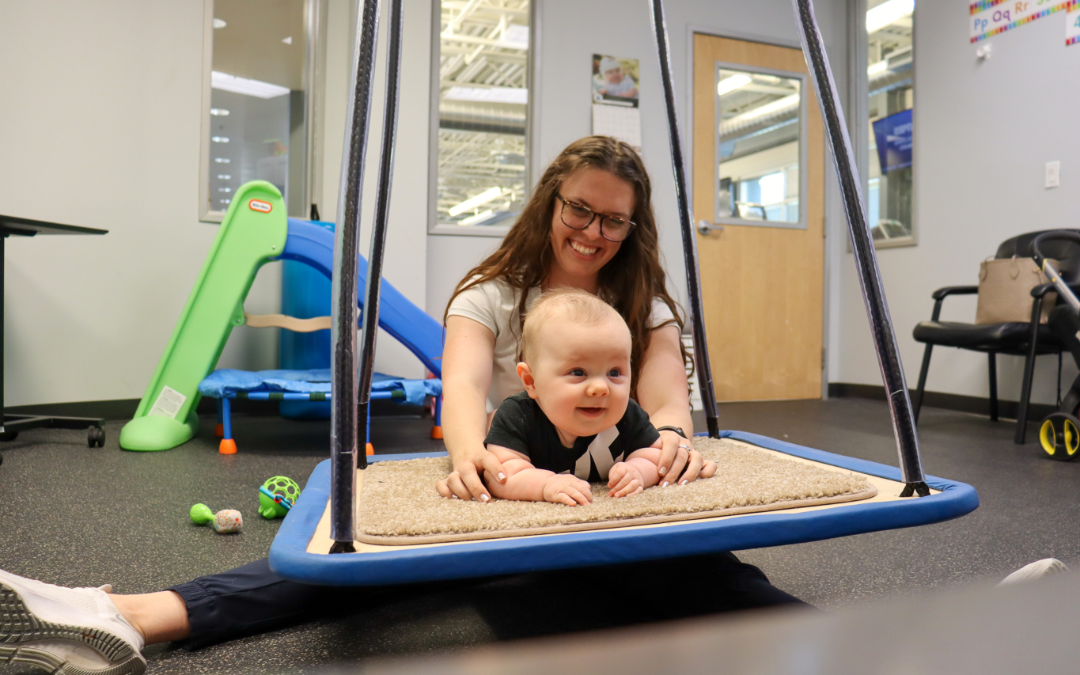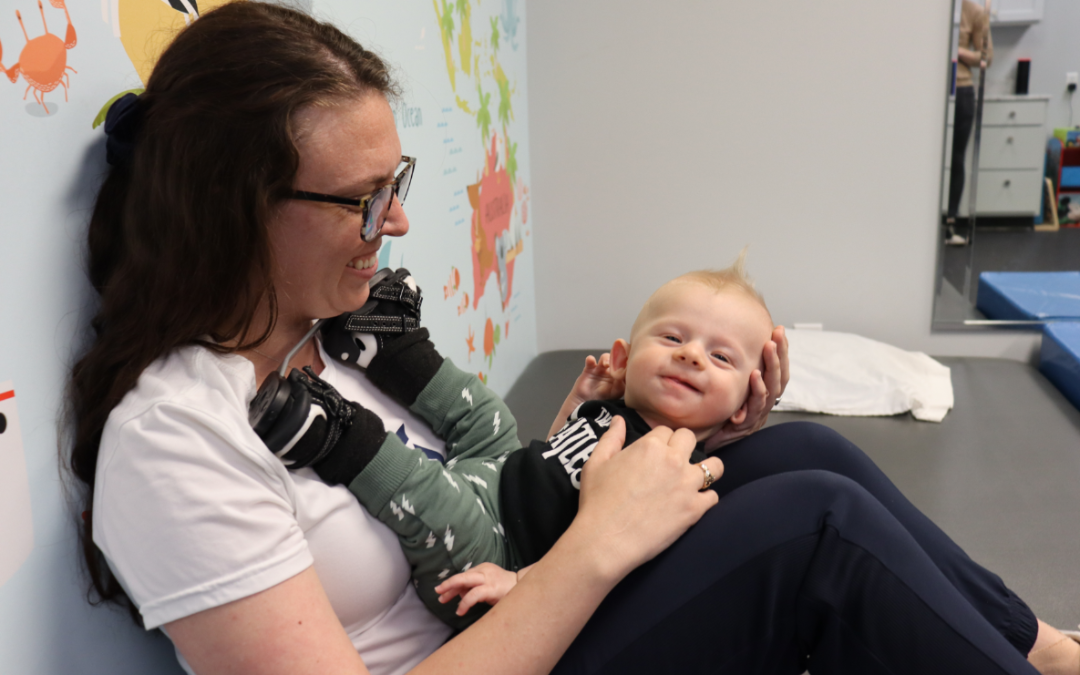By: Jessica Noel, PT, DPT
Becoming a first-time parent, or even adding another baby to the bunch, can be thrilling, terrifying, and exhausting all at the same time. You want the best for your baby, and you want to make sure your baby is happy and healthy.
Conditions like plagiocephaly, brachycephaly, and torticollis can sound scary or concerning as a parent, but they are common and completely treatable conditions with early identification and intervention.
What are Plagiocephaly and Brachycephaly?
As we know, babies grow so fast in the first few months of their lives. Notably, infants’ heads grow rapidly from the time they are born to around 6 months to accommodate their growing brain. They have soft spots on their skulls called fontanelles to allow for the skull and brain to grow, but they can make a baby’s skull susceptible to deformational changes, such as flattening on the back of the head (brachycephaly) or on the side of the head (plagiocephaly).
Babies are spending more time on their backs than in previous years. This is due to the back to sleep campaign, which has successfully reduced the likelihood of Sudden Infant Death (SIDS). While we have improved safe infant sleep in the past thirty years, the prevalence of head flattening in infants has increased. Nearly half of babies today have some skull deformation or head flattening (Mawji et all, 2013).
A flat spot is not just a cosmetic issue. It may result in difficulty reaching gross motor milestones. Therefore, early intervention is key. Once it has developed, head flattening is unlikely to go away without interventions such as repositioning or a cranial helmet. While repositioning is an effective early treatment in the first few months of the baby’s life, helmet treatment may be warranted in cases where repositioning is inadequate. Helmets are most effective between 4-6 months of age. After 18 months, due to the soft spots being fused, helmets are less effective and can take up to twice the amount of time to resolve a flat spot. The timing of treatment is of the essence to help children reach milestones and reduce the risk of permanent skull deformity and facial asymmetry.
What is Torticollis?
Some infants are born with Congenital Muscular Torticollis (CMT) as the result of positioning in the womb. This is a tightening of the neck muscles, particularly the sternocleidomastoid (SCM), which is just along the side of the neck from the back of the ear to the collarbone. This tightening can cause an infant to prefer looking in one direction and can actually lead to plagiocephaly. They can also develop tightness in surrounding muscles of the neck, the back, and abdomen which can further exacerbate both conditions.
If torticollis and plagiocephaly are not corrected early, it can lead to life-long issues including TMJ dysfunction, headaches, neck pain, difficulty wearing helmets, poorly fitted glasses, and facial asymmetry.
The Importance of Tummy Time
One way to help prevent plagiocephaly and brachycephaly is to utilize tummy time. Infants are spending more time on their back in containers like cribs, swings, bouncers, car seats, etc., than ever before without sufficient floor time to practice motor skills on their tummy and side.
Lack of opportunity to play on the floor can exacerbate plagiocephaly, inhibit motor coordination, and potentially lead to delayed milestones such as sitting, rolling, and crawling. It is important for infants to get tummy time for short periods several times throughout the day to build neck strength.
Tummy time can be performed on the floor, on a caregiver’s chest, or on a support pillow such as a boppy. To accumulate to an hour a day of this, parents can incrementally add in tummy time after diaper changes or other activities. The more opportunities for tummy time, the better!
The Role of Physical Therapy for Your Child
Physical therapists can help educate caregivers how to reposition the infant, gently stretch, improve oral motor skills for feeding, and encourage tummy time play. The goal of a PT is to promote age-appropriate development, gross motor skills, and alleviate body/neck tension.
Early referral to physical or occupational therapy can greatly reduce the risk of plagiocephaly or need for a cranial helmet. However, a therapist can also assist with making the timely referral to an orthotist if a cranial helmet is necessary.
If you are a new parent or guardian and notice your child has a bit of a flat spot on the back or back side of their head or prefer to look to one side, schedule an appointment with a Spooner pediatric therapist today. We want the best for your child, too!
For further information visit:
Babies Need Tummy Time!
Checking Your Baby for Signs of Plagiocephaly
References
- Aliyah Mawji, Ardene Robinson Vollman, Jennifer Hatfield, Deborah A. McNeil, Reginald Sauvé; The Incidence of Positional Plagiocephaly: A Cohort Study. Pediatrics August 2013; 132 (2): 298–304. 10.1542/peds.2012-3438. https://pubmed.ncbi.nlm.nih.gov/23837184/
- Hong Youl Kim, Yoon Kyu Chung, and Yong Oock Kim. Effectiveness of Helmet Cranial Remodeling in Older Infants with Positional Plagiocephaly. Arch Craniofac Surg. August 14, 2014; 15)2): 47-52. Doi: 10.7181/acfs.2014.15.2.47. https://pubmed.ncbi.nlm.nih.gov/28913190/
- Regina Fenton, C. S. (2019, Feb 01). A pediatric epidemic: Deformational plagiocephaly/brachycephaly and congenital muscular torticollis. Contemporary PEDS Journal, Vol 36 No 2, Volume 36, Issue 2, https://www.contemporarypediatrics.com/view/pediatric-epidemic-deformational-plagiocephalybrachycephaly-and-congenital-muscular. Retrieved from Contemporary PEDS Journal, Vol 36 No 2, Volume 36, Issue 2.
- Sudden Infant Death Syndrome. Retrieved from Centers for Disease Control and Prevention: https://www.cdc.gov/sids/data.htm#graph


